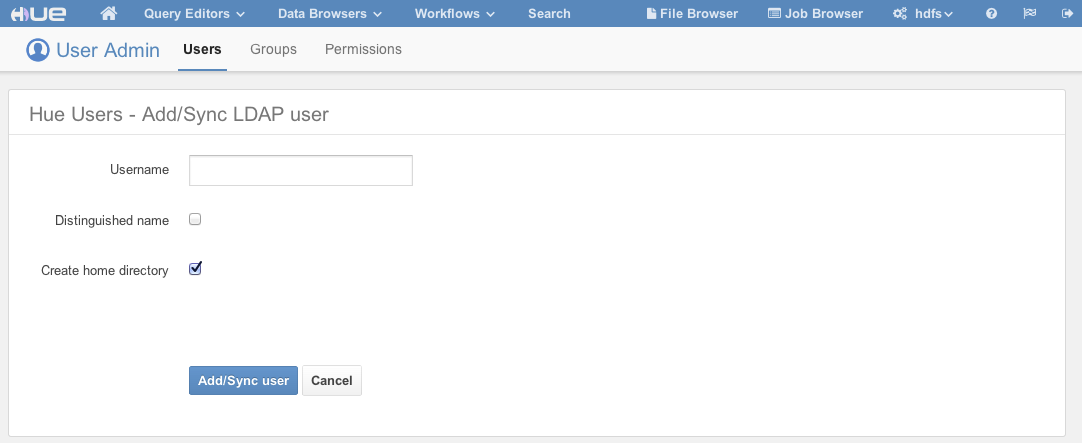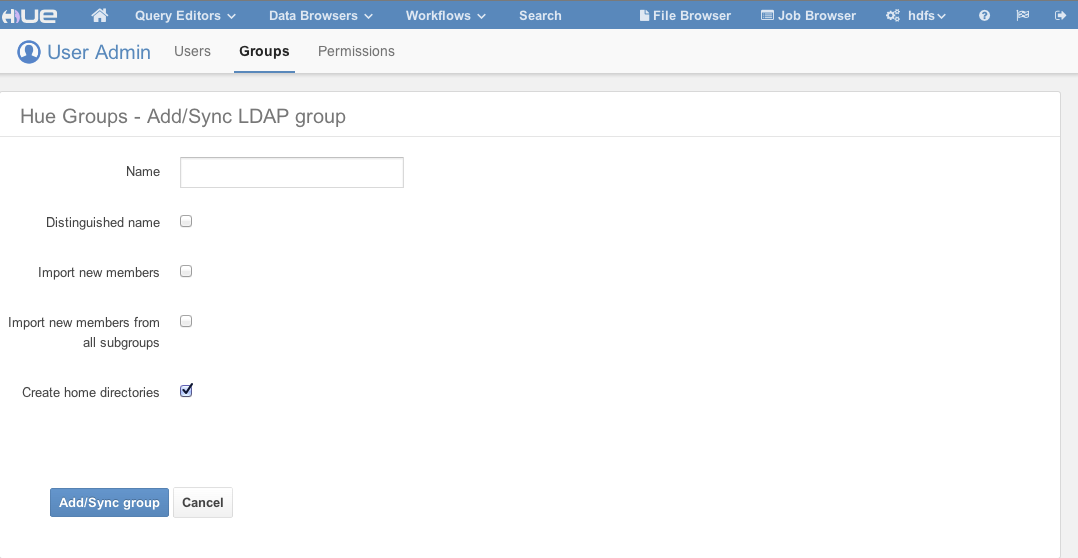Integrating Hue with LDAP
When Hue is integrated with LDAP users can use their existing credentials to authenticate and inherit their existing groups transparently. There is no need to save or duplicate any employee password in Hue. There are several other ways to authenticate with Hue such as PAM, SPNEGO, OpenID, OAuth, SAML2 and so on. This topic details how you can configure Hue to authenticate against an LDAP directory server.
[desktop] [[auth]] backend=desktop.auth.backend.LdapBackend
[desktop] [[ldap]] create_users_on_login=falseThe purpose of disabling the automatic import is to allow only a predefined list of manually imported users to login.
There are two ways to authenticate with a directory service through Hue:
| search_bind_authentication | Uses search bind authentication by default. Set this
property to false to use direct
bind authentication. Default: true |
Search Bind
The search bind mechanism for authenticating will perform an ldapsearch against the directory service and bind using the found distinguished name (DN) and password provided. This is the default method of authentication used by Hue with LDAP.The following configuration properties under the [desktop] > [[ldap]] > [[[users]]] section in hue.ini can be set to restrict the search process.
| user_filter | General LDAP filter to restrict the
search. Default: "objectclass=*" |
| user_name_attr | The attribute that will be considered the username to be
searched against. Typical attributes to search for include: uid, sAMAccountName. Default: sAMAccountName |
(&(objectClass=*)(sAMAccountName=<user entered usename>))
 Important
ImportantDirect Bind
The direct bind mechanism for authenticating will bind to the LDAP server using the username and password provided at login.
| nt_domain | The NT domain to connect to (only for use with Active
Directory). This AD-specific property allows Hue to authenticate with AD without
having to follow LDAP references to other partitions. This typically maps to the
email address of the user or the user's ID in conjunction with the domain. If provided, Hue will use User Principal Names (UPNs) to bind to the LDAP service. Default: mycompany.com |
| ldap_username_pattern | Provides a template for the DN that will ultimately be
sent to the directory service when authenticating. The <username> parameter will be
replaced with the username provided at login. Default: "uid=<username>,ou=People,dc=mycompany,dc=com" |
 Important
Important- nt_domain is specified: This is used to connect to an Active Directory service. In this case, the User Principal Name (UPN) is used to perform a direct bind. Hue forms the UPN by concatenating the short name provided at login with the nt_domain. For example, <short name>@<nt_domain>. The ldap_username_pattern property is ignored.
- nt_domain is not specified: This is used to connect to all other directory services (can handle Active Directory, but nt_domain is the preferred way for AD). In this case, ldap_username_pattern is used and it should take on the form cn=<username>,dc=example,dc=com where <username> will be replaced with the username provided at login.
Importing LDAP Users and Groups
If an LDAP user needs to be part of a certain group and be given a particular set of permissions, you can import this user with the User Admin interface in Hue.

Groups can also be imported using the User Admin interface, and users can be added to this group. As in the image below, not only can groups be discovered via DN and rDN search, but users that are members of the group or members of its subordinate groups can be imported as well.

You have the following options available when importing a user/group:
- Distinguished name: If checked, the username provided must be a full distinguished name (for example, uid=hue,ou=People,dc=gethue,dc=com). Otherwise, the Username provided should be a fragment of a Relative Distinguished Name (rDN) (for example, the username hue maps to the rDN uid=hue). Hue will perform an LDAP search using the same methods and configurations as described above. That is, Hue will take the provided username and create a search filter using the user_filter and user_name_attr configurations.
- Create home directory: If checked, when the user is imported, their home directory in HDFS will automatically be created if it doesn’t already exist.
 Important
ImportantSynchronizing LDAP Users and Groups
Users and groups can be synchronized with the directory service via the User Admin interface or via a command line utility. The image from the Importing LDAP Users and Groups section uses the words Add/Sync to indicate that when a user or group that already exists in Hue is being added, it will in fact be synchronized instead. In the case of importing users for a particular group, new users will be imported and existing users will be synchronized.
 Note
NoteAttributes Synchronized
Currently, only the first name, last name, and email address are synchronized. Hue looks for the LDAP attributes givenName, sn, and mail when synchronizing. The user_name_attr configuration property is used to appropriately choose the username in Hue. For instance, if user_name_attr’ is set to uid”, then the "uid" returned by the directory service will be used as the username of the user in Hue.
User Admin interface
The Sync LDAP users/groups button in the User Admin interface will automatically synchronize all users and groups.
Synchronize Using a Command-Line Interface
For example, to synchronize users and groups using a command-line interface:
<hue root>/build/env/bin/hue sync_ldap_users_and_groups
LDAPS/StartTLS support
[desktop]
[[ldap]]
ldap_cert=/etc/hue/ca.crt
[desktop]
[[ldap]]
use_start_tls=true
| << Configuring Hue to Support Hadoop Security using Kerberos | Configuring Hue for SAML >> | |